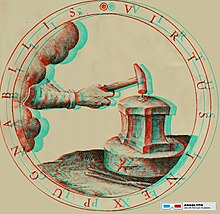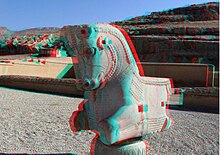
Back Anaqlifiya Azerbaijani Анаглифни изображения Bulgarian Anàglif Catalan Anaglyf Czech Anaglyf Danish Anaglyph 3D German Anaglifo Spanish تصویر برجسته Persian Anaglyphe French Anaiglif Irish

 3D red cyan glasses are recommended to view this image correctly.
3D red cyan glasses are recommended to view this image correctly.
 3D red cyan glasses are recommended to view this image correctly.
3D red cyan glasses are recommended to view this image correctly.
 3D red cyan glasses are recommended to view this image correctly.
3D red cyan glasses are recommended to view this image correctly.
 3D red cyan glasses are recommended to view this image correctly.
3D red cyan glasses are recommended to view this image correctly.Anaglyph 3D is the stereoscopic 3D effect achieved by means of encoding each eye's image using filters of different (usually chromatically opposite) colors, typically red and cyan. Anaglyph 3D images contain two differently filtered colored images, one for each eye. When viewed through the "color-coded" "anaglyph glasses", each of the two images reaches the eye it's intended for, revealing an integrated stereoscopic image. The visual cortex of the brain fuses this into the perception of a three-dimensional scene or composition.
Anaglyph images have seen a recent resurgence due to the presentation of images and video on the Web, Blu-ray Discs, CDs, and even in print. Low cost paper frames or plastic-framed glasses hold accurate color filters that typically, after 2002, make use of all 3 primary colors. The norm is red and cyan, with red being used for the left channel. The cheaper filter material used in the monochromatic past dictated red and blue for convenience and cost. There is a material improvement of full color images with the cyan filter, especially for accurate skin tones.
Video games, theatrical films, and DVDs can be shown in the anaglyph 3D process. Practical images, for science or design, where depth perception is useful, include the presentation of full scale and microscopic stereographic images. Examples from NASA include Mars rover imaging, and the solar investigation, called STEREO, which uses two orbital vehicles to obtain the 3D images of the sun. Other applications include geological illustrations by the United States Geological Survey, and various online museum objects. A recent application is for stereo imaging of the heart using 3D ultra-sound with plastic red/cyan glasses.
Anaglyph images are much easier to view than either parallel (diverging) or crossed-view pairs stereograms. However, these side-by-side types offer bright and accurate color rendering, not easily achieved with anaglyphs. Also, extended use of the "color-coded" "anaglyph glasses" can cause discomfort, and the afterimage caused by the colors of the glasses may temporarily affect the viewer's visual perception of real life objects. Recently,[timeframe?] cross-view prismatic glasses with adjustable masking have appeared, that offer a wider image on the new HD video and computer monitors.
© MMXXIII Rich X Search. We shall prevail. All rights reserved. Rich X Search